Land Use and Land Cover Scenarios for Optimum Water Yield and Sediment Retention Ecosystem Services in Klong U-Tapao Watershed, Songkhla, Thailand
Abstract
1. Introduction
2. Materials and Methods
2.1. Study Area
2.2. Research Methodology
2.2.1. LULC Assessment and Its Change
2.2.2. LULC Prediction of Three Different Scenarios
2.2.3. Ecosystem Service Assessment on Water Yield and Sediment Retention
Water Yield Estimation
−0.738 × clay% + 0.007 × (clay%) 2 − 2.688 × OM% + 0.501 × (OM%) 2
Sediment Retention Estimation
2.2.4. LULC Scenario Identification for Optimum Water Yield and Sediment Retention
3. Results
3.1. LULC Assessment and Its Change
3.2. LULC Prediction of Three Different Scenarios
3.3. Water Yield Ecosystem Service Assessment
3.4. Sediment Retention Ecosystem Service Assessment
3.5. LULC Scenario Identification for Optimum Water Yield and Soil Retention Ecosystem Services
4. Discussion
4.1. LULC Assessment, Change, and Trend
4.2. LULC Prediction by CLUE-S Model
4.3. Water Yield Estimation
4.4. Sediment Retention Estimation
4.5. Optimum LULC Scenario for Ecosystem Services
5. Conclusions
Author Contributions
Funding
Acknowledgments
Conflicts of Interest
Appendix A
| LULC Type | Root Depth (mm) | Kc | References |
|---|---|---|---|
| Urban and built-up area | 0 | 0.3 | [45,80] |
| Paddy field | 400 | 0.6 | [81] |
| Rubber plantation | 2500 | 0.9 | [45,80] |
| Oil palm plantation | 2000 | 0.9 | [45,80] |
| Perennial tree and orchard | 3000 | 0.95 | [45,80] |
| Aquatic cultural area | 0 | 0 | [45,80] |
| Evergreen forest | 7300 | 1 | [45,80] |
| Mangrove forest | 500 | 1 | [45,80] |
| Marsh and swamp | 200 | 0.7 | [82] |
| Water body | 0 | 0 | [45,80] |
| Miscellaneous land | 0 | 0 | [45,80] |
| Soil Series | Erodibility Factor Value | Soil Series | Erodibility Factor Value |
|---|---|---|---|
| Ban Thon series | 0.20 | Rangae/Tha Chin association | 0.14 |
| Bang Klam series | 0.12 | Rangae series | 0.20 |
| Bang Nara/Kokiean association | 0.30 | Ranong/Hat Yai association | 0.32 |
| Bang Nara series | 0.26 | Ranong/Phato association | 0.25 |
| Chumphon/Sawi association | 0.28 | Ranong series | 0.23 |
| Chumphon series | 0.28 | Ranote series | 0.14 |
| Complex of well drained, levee soil | 0.22 | Rayong series | 0.23 |
| Hat Yai/Padang Baser association | 0.27 | Residential | 0.11 |
| Hat Yai series | 0.27 | Ruso series | 0.22 |
| Khlong Nok Kra Thung series | 0.20 | Sai Buri fine clayey variant | 0.26 |
| Khlong Thom series | 0.25 | Sai Buri, fine clayey variant/Ruso association | 0.28 |
| Kho Hong/Tha Sae, mottled variant association | 0.27 | Sai Kao, somewhat excessively drianed variant | 0.25 |
| Kho Hong series | 0.24 | Samut Prakan series | 0.17 |
| Khok Khian fine sand fraction variant | 0.17 | Sathon series | 0.28 |
| Khok Khian series | 0.24 | Sawi series | 0.20 |
| Klaeng series | 0.27 | Slope Complex | 0.21 |
| La Harn series | 0.22 | Songkla Lake | 0.07 |
| Lang Suan series | 0.13 | Swamp | 0.24 |
| Nam Krachai/Kho Hong association | 0.23 | Tha Sae, mottled variant | 0.25 |
| Nam Krachai series | 0.23 | Tha Sae, mottled variant/Klaeng association | 0.27 |
| Padang Besar series | 0.28 | Thung Wa series | 0.21 |
| Pawong/Rangae association | 0.23 | Tin mine land | 0.20 |
| Pawong series | 0.14 | Visai complex | 0.29 |
| Phato series | 0.22 | Visai series | 0.24 |
| Puket series | 0.20 | Yala series | 0.27 |
| LULC Type | C Factor | P Factor |
|---|---|---|
| Urban and built-up area | 0 | 0 |
| Paddy field | 0.4 | 1 |
| Rubber plantation | 0.22 | 1 |
| Oil palm plantation | 0.3 | 1 |
| Perennial tree and orchard | 0.3 | 1 |
| Aquatic culture area | 0 | 0 |
| Evergreen forest | 0.001 | 1 |
| Mangrove forest | 0 | 0 |
| Marsh and swamp | 0.40 | 1 |
| Water body | 0 | 0 |
| Miscellaneous land | 0.6 | 1 |
References
- Chiang, L.-C.; Chuang, Y.-T.; Han, C.-C. Integrating Landscape Metrics and Hydrologic Modeling to Assess the Impact of Natural Disturbances on Ecohydrological Processes in the Chenyulan Watershed, Taiwan. Int. J. Environ. Res. Public Health 2019, 16, 266. [Google Scholar] [CrossRef]
- Tallis, H.T.; Ricketts, T.; Guerry, A.D.; Nelson, E.; Ennaanay, D.; Wolny, S.; Olwero, N.; Vigerstol, K.; Pennington, D.; Mendoza, G.; et al. InVEST 2.1 Beta User’s Guide: Integrated Valuation of Ecosystem Services and Tradeoff; Stanford University: Stanford, CA, USA, 2011. [Google Scholar]
- Shoyama, K.; Yamagata, Y. Predicting land-use change for biodiversity conservation and climate-change mitigation and its effect on ecosystem services in a watershed in Japan. Ecosyst. Serv. 2014, 8, 25–34. [Google Scholar] [CrossRef]
- Guardiola-Claramonte, M.; Troch, P.A.; Ziegler, A.D.; Giambelluca, T.W.; Durcik, M.; Vogler, J.B.; Nullet, M.A. Hydrologic effects of the expansion of rubber (Hevea brasiliensis) in a tropical catchment. Ecohydrology 2010, 3, 306–314. [Google Scholar] [CrossRef]
- Hamilton, L.S. Forest and Water: A Thematic Study Prepared in the Frame-Work of the Global Forest Resources Assessment 2005; FAO: Rome, Italy, 2008. [Google Scholar]
- Suryatmojo, H.; Fujimoto, M.; Yamakawa, Y.; Kosugi, K.I.; Mizuyama, T. Water balance changes in the tropical rainforest with intensive forest management system. Int. J. Sustain. Future Hum. Secur. 2013, 1, 56–62. [Google Scholar] [CrossRef]
- Morgan, R.P.C. Soil Erosion and Conservation, 2nd ed.; Longman Group Ltd: Harlow, UK, 1995. [Google Scholar]
- Gregersen, J.B.; Gijsbers, P.J.A.; Westen, S.J.P. OpenMI: Open modelling interface. J. Hydroinform. 2007, 9, 175–191. [Google Scholar] [CrossRef]
- Dutta, S. Soil erosion, sediment yield and sedimentation of reservoir: A review. Model. Earth Syst. Environ. 2016, 2, 123. [Google Scholar] [CrossRef]
- Hajigholizadeh, M.; Melesse, A.M.; Fuentes, H.R. Erosion and Sediment Transport Modelling in Shallow Waters: A Review on Approaches, Models and Applications. Int. J. Environ. Res. Public Health 2018, 15, 518. [Google Scholar] [CrossRef] [PubMed]
- Boonkaewwan, S. Impacts of land-use changes on watershed discharge and water quality in a large intensive agricultural area in Thailand AU—Chotpantarat, Srilert. Hydrol. Sci. J. 2018, 63, 1386–1407. [Google Scholar] [CrossRef]
- Wuttichaikitcharoen, P.; Babel, S.M. Principal Component and Multiple Regression Analyses for the Estimation of Suspended Sediment Yield in Ungauged Basins of Northern Thailand. Water 2014, 6, 2412–2435. [Google Scholar] [CrossRef]
- Bogdan, S.-M.; Pătru-Stupariu, I.; Zaharia, L. The Assessment of Regulatory Ecosystem Services: The Case of the Sediment Retention Service in a Mountain Landscape in the Southern Romanian Carpathians. Procedia Environ. Sci. 2016, 32, 12–27. [Google Scholar] [CrossRef]
- Wang, H.-W.; Kondolf, M.; Tullos, D.; Kuo, W.-C. Sediment Management in Taiwan’s Reservoirs and Barriers to Implementation. Water 2018, 10, 1034. [Google Scholar] [CrossRef]
- Kondolf, G.M.; Gao, Y.; Annandale, G.W.; Morris, G.L.; Jiang, E.; Zhang, J.; Cao, Y.; Carling, P.; Fu, K.; Guo, Q.; et al. Sustainable sediment management in reservoirs and regulated rivers: Experiences from five continents. Earth’s Future 2014, 2, 256–280. [Google Scholar] [CrossRef]
- Rahmani, V.; Kastens, J.H.; DeNoyelles, F.; Jakubauskas, M.E.; Martinko, E.A.; Huggins, D.H.; Gnau, C.; Liechti, P.M.; Campbell, S.W.; Callihan, R.A.; et al. Examining Storage Capacity Loss and Sedimentation Rate of Large Reservoirs in the Central U.S. Great Plains. Water 2018, 10, 190. [Google Scholar] [CrossRef]
- Wohl, E.; Bledsoe, B.P.; Jacobson, R.B.; Poff, N.L.; Rathburn, S.L.; Walters, D.M.; Wilcox, A.C. The Natural Sediment Regime in Rivers: Broadening the Foundation for Ecosystem Management. BioScience 2015, 65, 358–371. [Google Scholar] [CrossRef]
- Hamel, P.; Falinski, K.; Sharp, R.; Auerbach, D.A.; Sánchez-Canales, M.; Dennedy-Frank, P.J. Sediment delivery modeling in practice: Comparing the effects of watershed characteristics and data resolution across hydroclimatic regions. Sci. Total Environ. 2017, 580, 1381–1388. [Google Scholar] [CrossRef]
- Han, X.; Lv, P.; Zhao, S.; Sun, Y.; Yan, S.; Wang, M.; Han, X.; Wang, X. The Effect of the Gully Land Consolidation Project on Soil Erosion and Crop Production on a Typical Watershed in the Loess Plateau. Land 2018, 7, 113. [Google Scholar] [CrossRef]
- Gurung, K.; Yang, J.; Fang, L. Assessing Ecosystem Services from the Forestry-Based Reclamation of Surface Mined Areas in the North Fork of the Kentucky River Watershed. Forests 2018, 9, 652. [Google Scholar] [CrossRef]
- Lane, L.J.; Nichols, M.H.; Levick, L.R.; Kidwell, M.R. A Simulation Model for Erosion and Sediment Yield at the Hillslope Scale. In Landscape Erosion and Evolution Modeling; Harmon, R.S., Doe, W.W., Eds.; Springer: Boston, MA, USA, 2001; pp. 201–237. [Google Scholar] [CrossRef]
- Abdulkareem, J.H.; Pradhan, B.; Sulaiman, W.N.A.; Jamil, N.R. Prediction of spatial soil loss impacted by long-term land-use/land-cover change in a tropical watershed. Geosci. Front. 2019, 10, 389–403. [Google Scholar] [CrossRef]
- Ahrends, A.; Hollingsworth, P.M.; Ziegler, A.D.; Fox, J.M.; Chen, H.; Su, Y.; Xu, J. Current trends of rubber plantation expansion may threaten biodiversity and livelihoods. Glob. Environ. Chang. 2015, 34, 48–58. [Google Scholar] [CrossRef]
- Asari, N.; Suratman, M.N.; Jaafar, J. Modelling and mapping of above ground biomass (AGB) of oil palm plantations in Malaysia using remotely-sensed data. Int. J. Remote Sens. 2017, 38, 4741–4764. [Google Scholar] [CrossRef]
- Razak, J.A.B.A.; Shariff, A.R.B.M.; Ahmad, N.B.; Ibrahim Sameen, M. Mapping rubber trees based on phenological analysis of Landsat time series data-sets. Geocarto Int. 2018, 33, 627–650. [Google Scholar] [CrossRef]
- Ye, S.; Rogan, J.; Sangermano, F. Monitoring rubber plantation expansion using Landsat data time series and a Shapelet-based approach. ISPRS J. Photogramm. Remote Sens. 2018, 136, 134–143. [Google Scholar] [CrossRef]
- Tian, S.; Zhang, X.; Tian, J.; Sun, Q. Random Forest Classification of Wetland Landcovers from Multi-Sensor Data in the Arid Region of Xinjiang, China. Remote Sens. 2016, 8, 954. [Google Scholar] [CrossRef]
- Teluguntla, P.; Thenkabail, P.S.; Oliphant, A.; Xiong, J.; Gumma, M.K.; Congalton, R.G.; Yadav, K.; Huete, A. A 30-m landsat-derived cropland extent product of Australia and China using random forest machine learning algorithm on Google Earth Engine cloud computing platform. ISPRS J. Photogramm. Remote Sens. 2018, 144, 325–340. [Google Scholar] [CrossRef]
- Trisurat, Y.; Eawpanich, P.; Kalliola, R. Integrating land use and climate change scenarios and models into assessment of forested watershed services in Southern Thailand. Environ. Res. 2016, 147, 611–620. [Google Scholar] [CrossRef] [PubMed]
- Trisurat, Y.; Shirakawa, H.; Johnston, J.M. Land-Use/Land-Cover Change from Socio-Economic Drivers and Their Impact on Biodiversity in Nan Province, Thailand. Sustainability 2019, 11, 649. [Google Scholar] [CrossRef]
- Ongsomwang, S.; Boonchoo, K. Integration of geospatial models for the allocation of deforestation hotspots and forest protection units. Suranaree J. Sci. Technol. 2016, 23, 283–307. [Google Scholar]
- Verburg, P.H.; de Koning, G.H.J.; Kok, K.; Veldkamp, A.; Bouma, J. A spatial explicit allocation procedure for modelling the pattern of land use change based upon actual land use. Ecol. Model. 1999, 116, 45–61. [Google Scholar] [CrossRef]
- Lüke, A.; Hack, J. Comparing the Applicability of Commonly Used Hydrological Ecosystem Services Models for Integrated Decision-Support. Sustainability 2018, 10, 346. [Google Scholar] [CrossRef]
- Arunyawat, S.; Shrestha, R. Assessing Land Use Change and Its Impact on Ecosystem Services in Northern Thailand. Sustainability 2016, 8, 768. [Google Scholar] [CrossRef]
- Leh, M.D.K.; Matlock, M.D.; Cummings, E.C.; Nalley, L.L. Quantifying and mapping multiple ecosystem services change in West Africa. Agric. Ecosyst. Environ. 2013, 165, 6–18. [Google Scholar] [CrossRef]
- Ongsomwang, S.; Iamchuen, N. Integration of geospatial models for optimum land use allocation in three different scenarios. Suranaree J. Sci. Technol. 2015, 22, 19. [Google Scholar]
- Doungsuwan, N.; Ratanachai, C.; Somgpongchaiyakul, P.; Sangganjanavanich, P. Impacts Of The National Economic And Social Development Plan On Songkhla Lake Basin Development Thailand. Int. Bus. Econ. Res. J. 2013, 12, 7. [Google Scholar] [CrossRef][Green Version]
- Department of Mineral Resources. Geochemical Survey and Soil Erosion in Lower Songkhla Lake Basin; Department of Mineral Resources: Bangkok, Thailand, 2008.
- Gyawali, S.; Techato, K.; Yuangyai, C.; Musikavong, C. Assessment of Relationship between Land uses of Riparian Zone and Water Quality of River for Sustainable Development of River Basin, A Case Study of U-Tapao River Basin, Thailand. Procedia Environ. Sci. 2013, 17, 291–297. [Google Scholar] [CrossRef][Green Version]
- Van der Linden, S.; Rabe, A.; Held, M.; Jakimow, B.; Leitão, P.J.; Okujeni, A.; Schwieder, M.; Suess, S.; Hostert, P. The EnMAP-Box—A Toolbox and Application Programming Interface for EnMAP Data Processing. Remote Sens. 2015, 7, 11249. [Google Scholar] [CrossRef]
- Breiman, L. Random Forests. Mach. Learn. 2001, 45, 5–32. [Google Scholar] [CrossRef]
- Congalton, R.; Green, K. Assessing the Accuracy of Remotely Sensed Data; CRC Press: Boca Raton, FL, USA, 2009. [Google Scholar] [CrossRef]
- Verburg, P.H.; Soepboer, W.; Veldkamp, A.; Limpiada, R.; Espaldon, V.; Mastura, S.S.A. Modeling the Spatial Dynamics of Regional Land Use: The CLUE-S Model. Environ. Manag. 2002, 30, 391–405. [Google Scholar] [CrossRef]
- Verburg, P.H.; Overmars, K.P. Combining top-down and bottom-up dynamics in land use modeling: Exploring the future of abandoned farmlands in Europe with the Dyna-CLUE model. Landsc. Ecol. 2009, 24, 1167–1181. [Google Scholar] [CrossRef]
- Sharp, R.; Tallis, H.T.; Ricketts, T.; Guerry, A.D.; Wood, S.A.; Chaplin-Kramer, R.; Nelson, E.; Ennaanay, D.; Wolny, S.; Olwero, N.; et al. InVEST 3.2.0 User’s Guide; The Natural Capital Project; Stanford University: Stanford, CA, USA; University of Minnesota: Minneapolis, MN, USA; The Nature Conservancy: Arlington County, VA, USA; World Wildlife Fund: Gland, Switzerland, 2015. [Google Scholar]
- Thailand Meteorological Department. Climate Data (2000–2018) in Songkhla Province; Thai Meteorological Department: Songkhla, Thailand, 2018.
- National Center for Atmospheric Research (NCAR). Climate System Model, June 2004 version 3.0; NCAR: Boulder, CO, USA, 2004. [Google Scholar]
- Riahi, K.; Grubler, A.; Nakicenovic, N. Scenarios of long-term socio-economic and environmental development under climate stabilization. Technol. Forecast. Soc. Chang. 2007, 74, 887–935. [Google Scholar] [CrossRef]
- Land Development Department. Soil Map of Songkhla Province.; Ministry of Agriculture and Cooperatives: Bangkok, Thailand, 2001.
- Zhou, W.; Liu, G.; Pan, J.; Feng, X. Distribution of available soil water capacity in China. J. Geogr. Sci. 2005, 15, 3–12. [Google Scholar] [CrossRef]
- Droogers, P.; Allen, R.G. Estimating Reference Evapotranspiration Under Inaccurate Data Conditions. Irrig. Drain. Syst. 2002, 16, 33–45. [Google Scholar] [CrossRef]
- Renard, K.G.; Freimund, J.R. Using monthly precipitation data to estimate the R-factor in the revised USLE. J. Hydrol. 1994, 157, 287–306. [Google Scholar] [CrossRef]
- Wischmeier, W.H.; Smith, D.D. Predicting Rainfall Erosion Losses—A Guide to Conservation Planning; USDA, Science and Education Administration: Hyattsville, MD, USA, 1978.
- Arnoldus, H.M.J. An Approximation of the Rainfall Factor in the Universal Soil Loss Equation; John Wiley and Sons Ltd.: Chichester, UK, 1980; pp. 127–132. [Google Scholar]
- Land Development Department. Soil Erosion in Thailand; Land Development Department, Ministry of Agriculture and Cooperatives: Bangkok, Thailand, 2000.
- Borselli, L.; Cassi, P.; Torri, D. Prolegomena to sediment and flow connectivity in the landscape: A GIS and field numerical assessment. CATENA 2008, 75, 268–277. [Google Scholar] [CrossRef]
- Vigiak, O.; Malagó, A.; Bouraoui, F.; Vanmaercke, M.; Obreja, F.; Poesen, J.; Habersack, H.; Fehér, J.; Grošelj, S. Modelling sediment fluxes in the Danube River Basin with SWAT. Sci. Total Environ. 2017, 599–600, 992–1012. [Google Scholar] [CrossRef]
- Southern Region Irrigation Hydrology Center. Water Yield and Sedimentation; Southern Region Irrigation Hydrology Center: Phattalung, Thailand, 2018. [Google Scholar]
- Hair, J.F.; Black, W.C.; Babin, B.J.; Anderson, R.E. Multivariate Data Analysis, 7th ed.; Pearson: Harlow, UK, 2013. [Google Scholar]
- Rogerson, P. Statistical Methods for Geography: A Student’s Guide, 3rd ed.; SAGE: Los Angeles, CA, USA; London, UK, 2010. [Google Scholar]
- Chan-o-cha, P. National Broadcast by PM Prayut Chan-o-cha. 11 March 2016. Available online: http://thaiembdc.org/2016/03/14/nb-by-pm-march-11-2016 (accessed on 10 October 2018).
- Raksaseri, K. THAILAND: Firm on Protecting the Palm Oil Sector. Available online: http://www.aseannews.net/thailand-firm-protecting-palm-oil-sector/ (accessed on 23 May 2018).
- Motovilov, Y.G.; Gottschalk, L.; Engeland, K.; Rodhe, A. Validation of a distributed hydrological model against spatial observations. Agric. For. Meteorol. 1999, 98–99, 257–277. [Google Scholar] [CrossRef]
- Bank of Thailand. Manufacturing Production in the Southern Region. Available online: http://www2.bot.or.th/statistics/ReportPage.aspx?reportID=590&language=eng (accessed on 5 January 2018).
- Ministry of Agriculture and Cooperatives. A Guide to the Management of Agricultural Production in Zoning; Ministry of Agriculture and Cooperatives: Bangkok, Thailand, 2014.
- Fitzpatrick-Lins, K. Comparison of sampling procedures and data analysis for a land-use and land cover map. Photogramm. Eng. Remote Sens. 1981, 47, 343–351. [Google Scholar]
- Rodriguez-Galiano, V.F.; Ghimire, B.; Rogan, J.; Chica-Olmo, M.; Rigol-Sanchez, J.P. An assessment of the effectiveness of a random forest classifier for land-cover classification. ISPRS J. Photogramm. Remote Sens. 2012, 67, 93–104. [Google Scholar] [CrossRef]
- Li, M.; Im, J.; Beier, C. Machine learning approaches for forest classification and change analysis using multi-temporal Landsat TM images over Huntington Wildlife Forest. GISci. Remote Sens. 2013, 50, 361–384. [Google Scholar] [CrossRef]
- Sakuma, A.; Kameyama, S.; Ono, S.; Kizuka, T.; Mikami, H. Mapping of Unused Agricultural Land Distribution Using Landsat 8 OLI Surface Reflectance Products in the Kushiro River Watershed. J. Remote Sens. Soc. Jpn. 2017, 37, 421–433. [Google Scholar] [CrossRef]
- Nguyen, H.T.T.; Doan, T.M.; Radeloff, V. APPLYING RANDOM FOREST CLASSIFICATION TO MAP LAND USE/LAND COVER USING LANDSAT 8 OLI. Int. Arch. Photogramm. Remote Sens. Spat. Inf. Sci. 2018, XLII-3/W4, 363–367. [Google Scholar] [CrossRef]
- Tatsumi, K.; Yamashiki, Y.; Torres, M.A.C.; Taipe, C.L.R. Crop classification of upland fields using Random forest of time-series Landsat 7 ETM+ data. Comput. Electron. Agric. 2015, 115, 171–179. [Google Scholar] [CrossRef]
- van Asselen, S.; Verburg, P.H. Land cover change or land-use intensification: Simulating land system change with a global-scale land change model. Glob. Chang. Biol. 2013, 19, 3648–3667. [Google Scholar] [CrossRef]
- Liu, W.; Luo, Q.; Li, J.; Wang, P.; Lu, H.; Liu, W.; Li, H. The effects of conversion of tropical rainforest to rubber plantation on splash erosion in Xishuangbanna, SW China. Hydrol. Res. 2013, 46, 168–174. [Google Scholar] [CrossRef]
- Xu, L.; Li, Z.; Song, H.; Yin, H. Land-Use Planning for Urban Sprawl Based on the CLUE-S Model: A Case Study of Guangzhou, China. Entropy 2013, 15, 3490–3506. [Google Scholar] [CrossRef]
- Pontius, R.G.; Schneider, L.C. Land-cover change model validation by an ROC method for the Ipswich watershed, Massachusetts, USA. Agric. Ecosyst. Environ. 2001, 85, 239–248. [Google Scholar] [CrossRef]
- Boonchoo, K. Geospatial Models for Land Use and Land Cover Prediction and Deforestation Vulnerability Analysis in Phuket Island, Thailand. Ph.D Thesis, Suranaree University of Technology, Nakhon Ratchasima, Thailand, 2015. [Google Scholar]
- Tarigan, S.; Wiegand, K.; Slamet, B. Minimum forest cover required for sustainable water flow regulation of a watershed: A case study in Jambi Province, Indonesia. Hydrol. Earth Syst. Sci. 2018, 22, 581–594. [Google Scholar] [CrossRef]
- Comte, I.; Colin, F.; Whalen, J.K.; Grünberger, O.; Caliman, J.-P. Chapter three—Agricultural Practices in Oil Palm Plantations and Their Impact on Hydrological Changes, Nutrient Fluxes and Water Quality in Indonesia: A Review. In Advances in Agronomy; Sparks, D.L., Ed.; Academic Press: Cambridge, MA, USA, 2012; Volume 116, pp. 71–124. [Google Scholar]
- Meijide, A.; Röll, A.; Fan, Y.; Herbst, M.; Niu, F.; Tiedemann, F.; June, T.; Rauf, A.; Hölscher, D.; Knohl, A. Controls of water and energy fluxes in oil palm plantations: Environmental variables and oil palm age. Agric. For. Meteorol. 2017, 239, 71–85. [Google Scholar] [CrossRef]
- Canadell, J.; Jackson, R.B.; Ehleringer, J.B.; Mooney, H.A.; Sala, O.E.; Schulze, E.D. Maximum rooting depth of vegetation types at the global scale. Oecologia 1996, 108, 583–595. [Google Scholar] [CrossRef]
- Philip, K.; Maxene, A.; Steve, S.; Stacey, W.; Ethan, F.; Gregg, M.; Juan Carlos, M.-S.; Françoise, B.; Landy Sabrina, C.; Jean Roudy, A.; et al. Baseline Ecological Inventory for Three Bays National Park, Haiti; The Nature Conservancy: Arlington County, VA, USA, 2016. [Google Scholar]
- Allen, R.G.; Pereira, L.S.; Raes, D.; Smith, M. Crop Evapotranspiration Guidelines for Computing Crop Water Requirements; FAO Irrigation and Drainage: Rome, Italy, 1998. [Google Scholar]
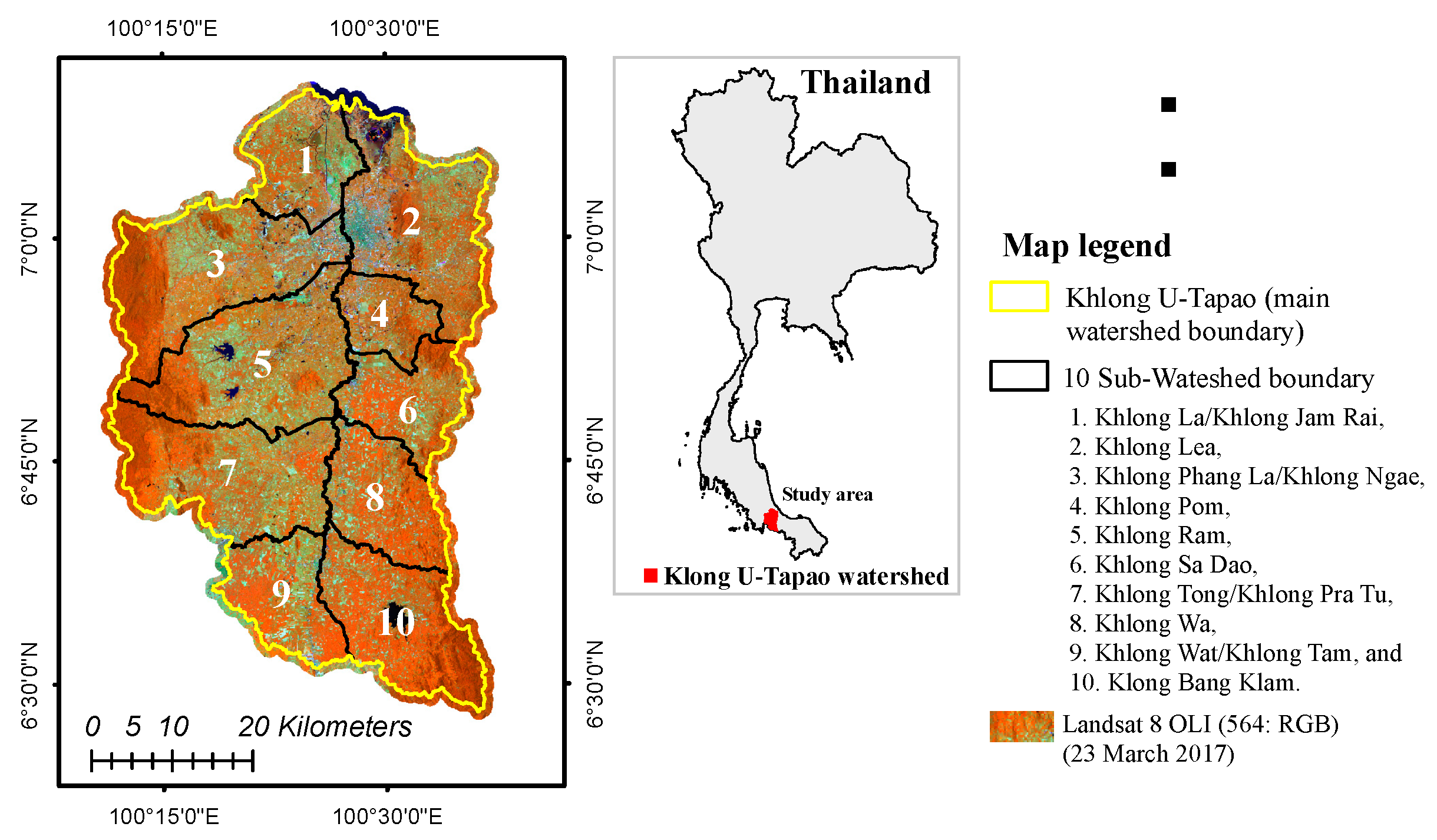
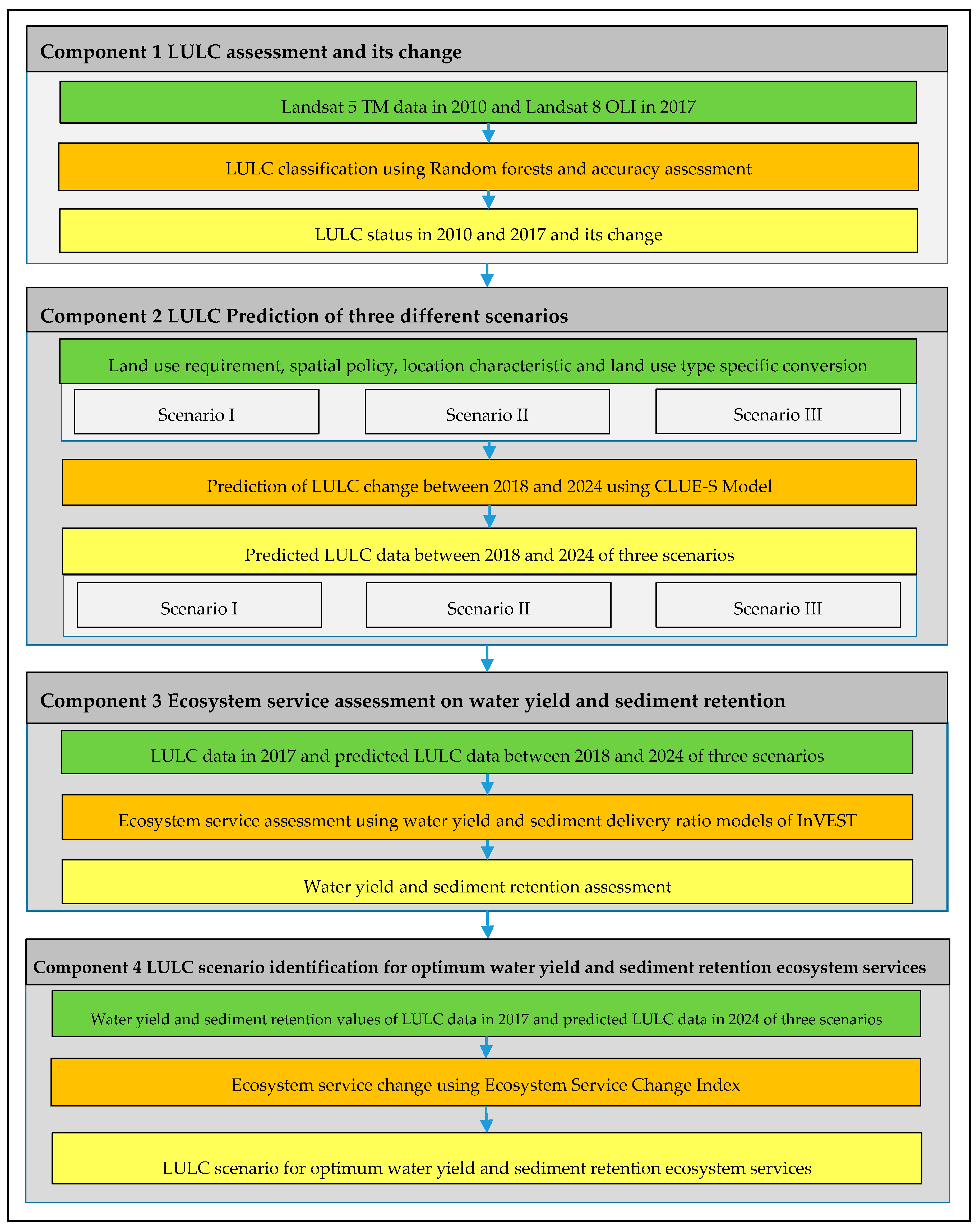
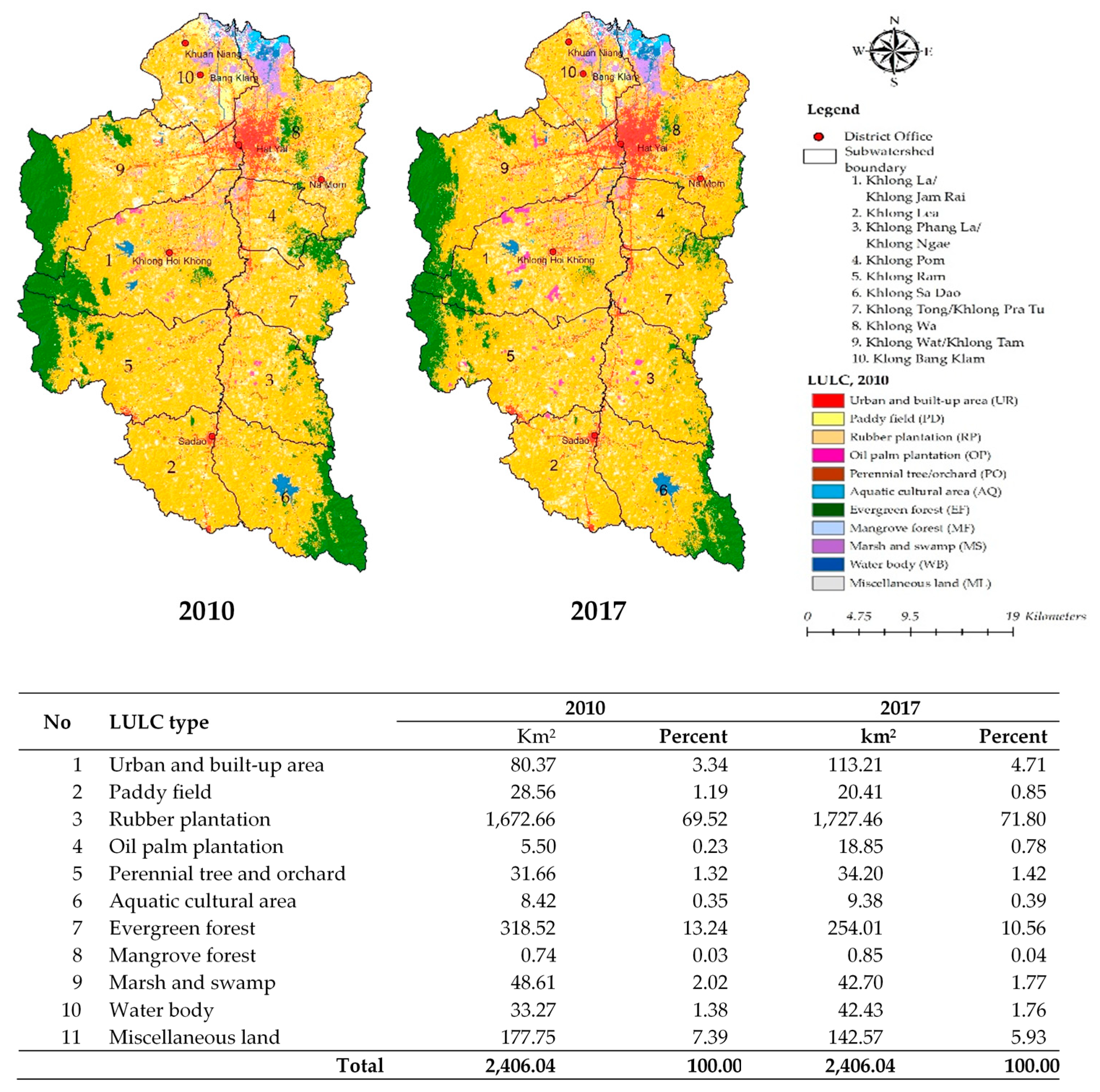
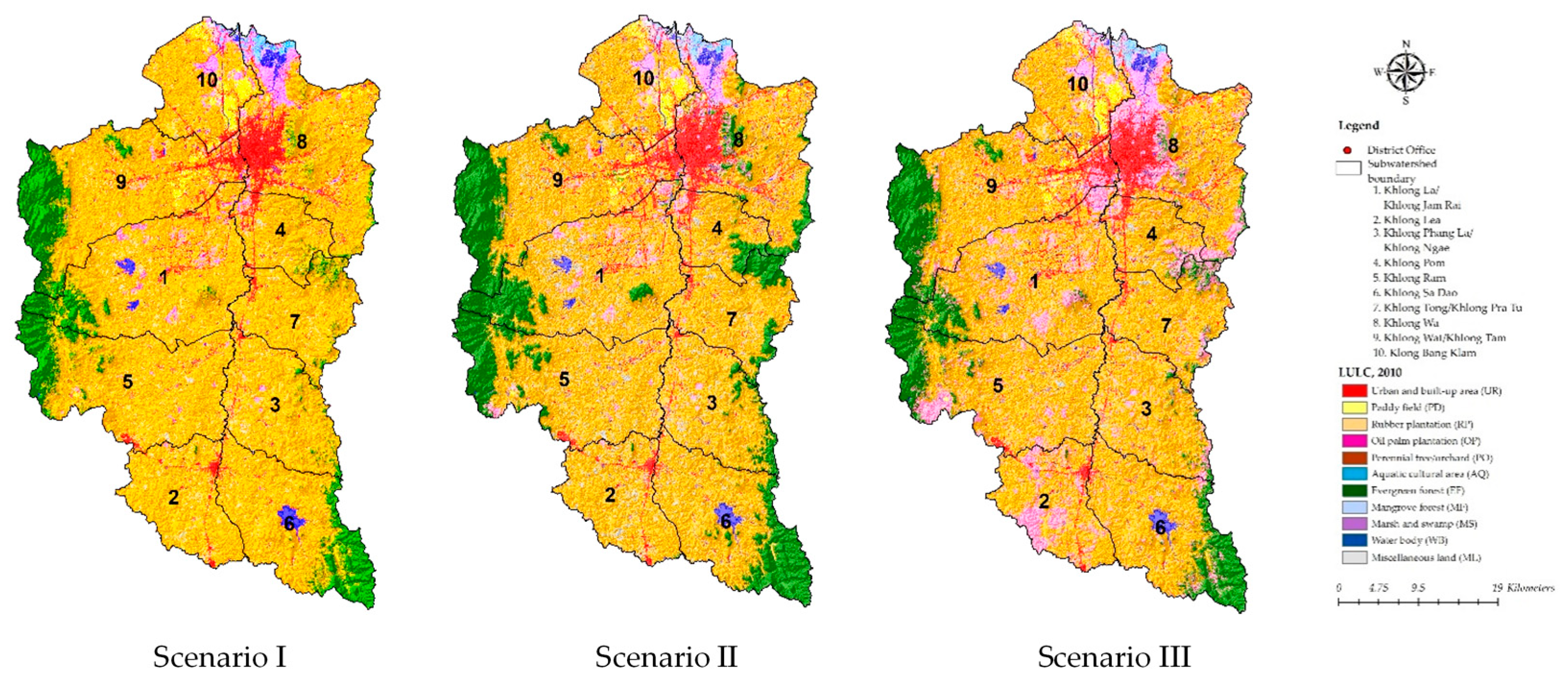
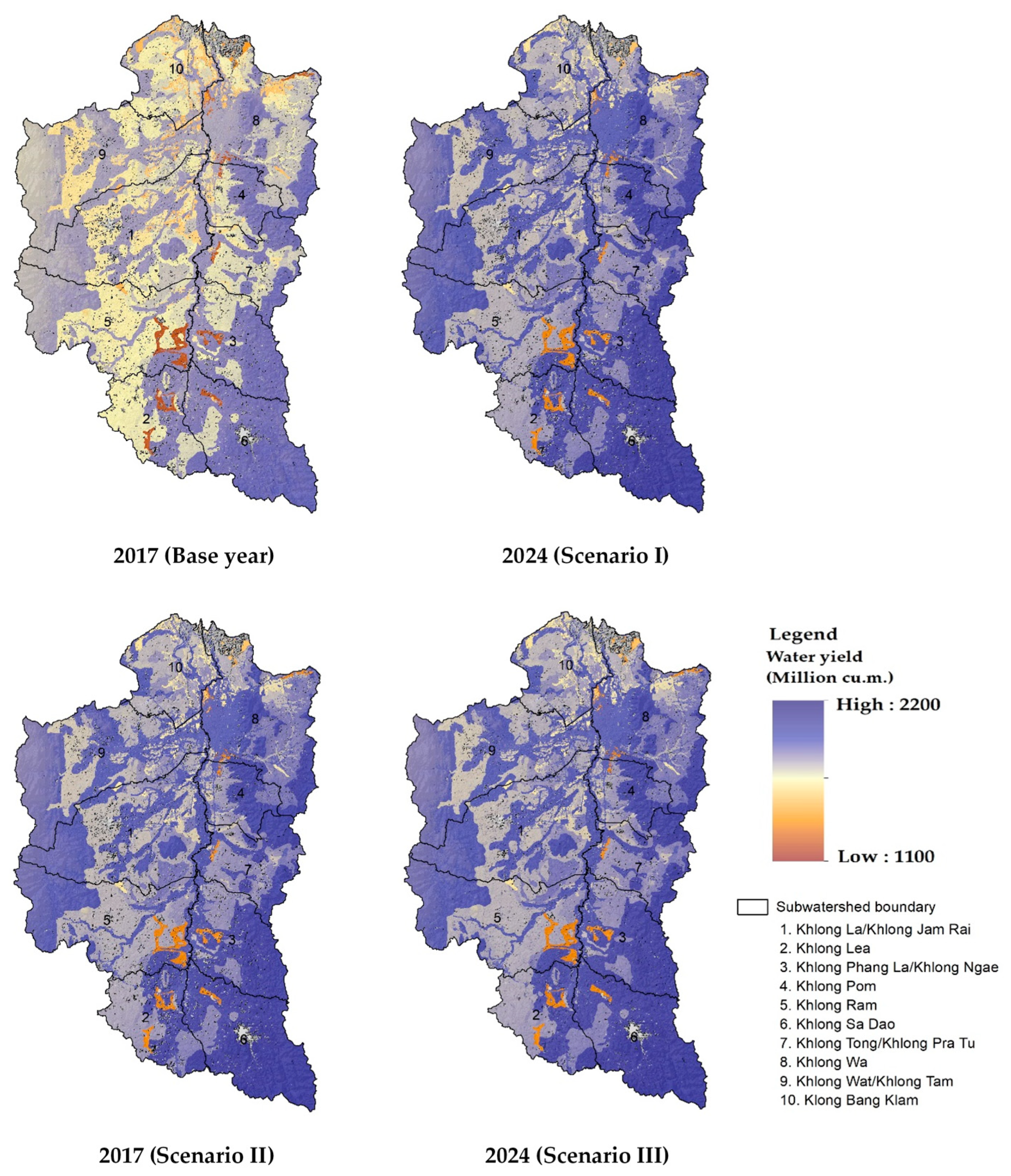
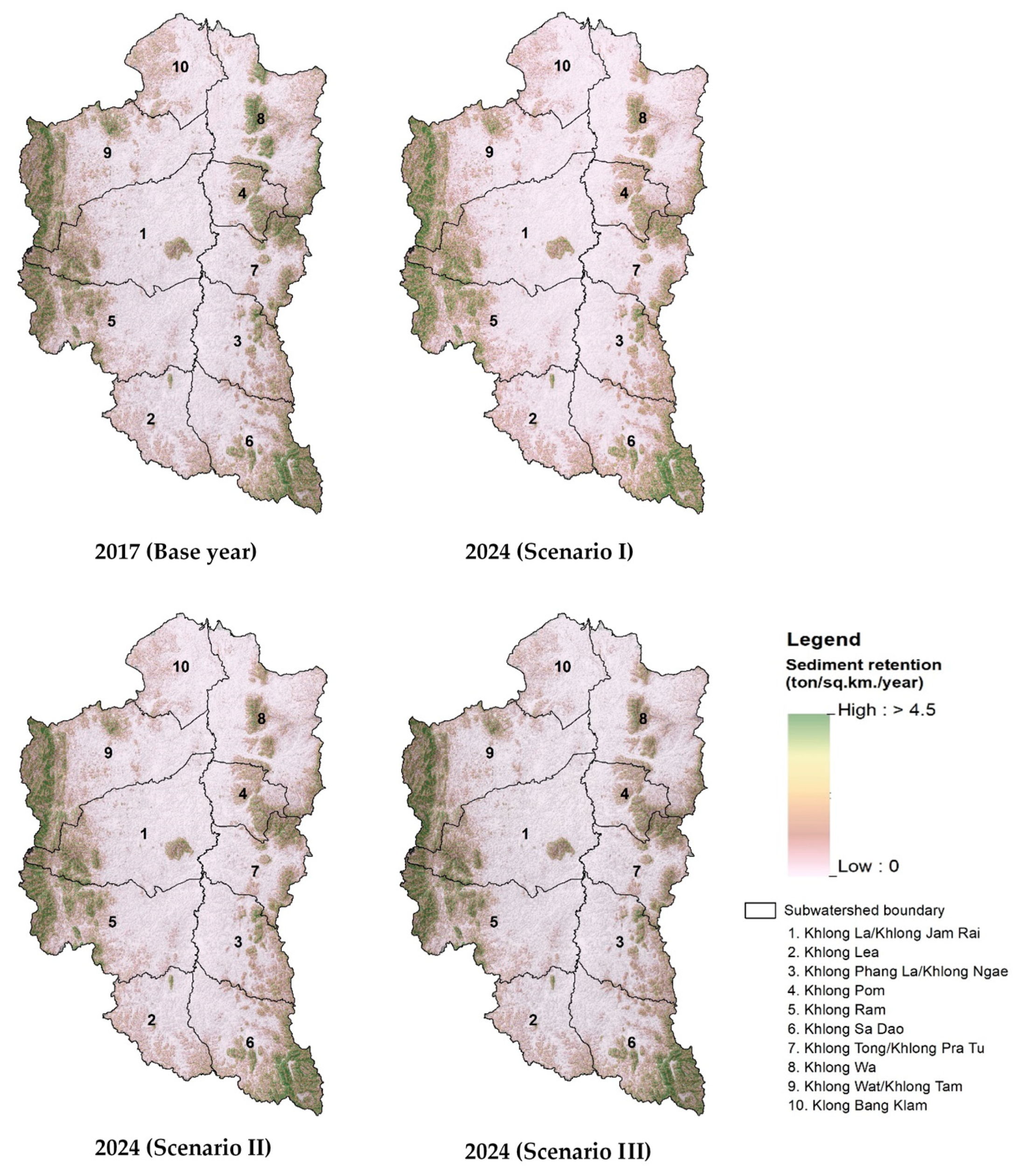
| LULC Type | Base Line Data in 2017 (Km2) | Land Requirement in 2024 (Km2) | ||
|---|---|---|---|---|
| Scenario I | Scenario II | Scenario III | ||
| Urban and built-up area | 113.21 | 145.4 1 | 145.4 1 | 145.41 1 |
| Paddy field | 20.41 | 14.59 1 | 20.4 2 | 20.41 2 |
| Rubber plantation | 1,727.46 | 1,736.85 1 | 1,568.17 3 | 1,524.88 4 |
| Oil palm plantation | 18.85 | 32.35 1 | 32.35 1 | 259.51 5 |
| Perennial tree/orchard | 34.20 | 37.05 1 | 34.20 2 | 34.20 2 |
| Aquatic cultural area | 9.38 | 10.18 1 | 9.38 2 | 9.38 2 |
| Evergreen forest | 254.01 | 202.57 1 | 377.47 6 | 254.01 2 |
| Mangrove forest | 0.85 | 0.93 1 | 0.85 2 | 0.85 2 |
| Marsh and swamp | 42.70 | 37.50 1 | 42.70 2 | 37.50 1 |
| Water body | 42.43 | 50.93 1 | 42.43 2 | 42.43 2 |
| Miscellaneous land | 142.57 | 137.72 1 | 132.69 7 | 77.49 8 |
| LULC Types | LULC 2017 (km2) | ||||||||||||
|---|---|---|---|---|---|---|---|---|---|---|---|---|---|
| UR | PD | RP | OP | PO | AQ | EF | MF | MS | WA | ML | Total | ||
| LULC2 010 (km2) | Urban and built-up area (UR) | 80.37 | - | - | - | - | - | - | - | - | - | - | 80.37 |
| Paddy field (PD) | 0.61 | 20.41 | 6.55 | 0.02 | 0.08 | - | - | - | - | 0.20 | 0.70 | 28.56 | |
| Rubber plantation (RP) | 24.52 | - | 1528.37 | 12.06 | - | - | - | - | - | 6.78 | 100.93 | 1672.66 | |
| Oil palm plantation (OP) | - | - | - | 5.50 | - | - | - | - | - | - | - | 5.50 | |
| Perennial tree/orchard (PO) | 0.67 | - | - | - | 30.43 | - | - | - | - | - | 0.57 | 31.66 | |
| Aquatic cultural area (AQ) | - | - | - | - | - | 8.42 | - | - | - | - | - | 8.42 | |
| Evergreen forest (EF) | 0.05 | - | 63.33 | 0.14 | 0.30 | - | 254.01 | - | - | 0.20 | 0.49 | 318.52 | |
| Mangrove forest (MF) | - | - | - | 0.01 | - | 0.02 | - | 0.64 | - | 0.02 | 0.06 | 0.74 | |
| Marsh and swamp (MS) | 0.93 | - | - | 0.28 | 0.16 | 0.40 | - | 0.22 | 42.70 | 1.37 | 2.56 | 48.61 | |
| Water body (WA) | - | - | - | - | - | - | - | - | - | 32.21 | 1.06 | 33.27 | |
| Miscellaneous land (ML) | 6.07 | - | 129.21 | 0.85 | 3.24 | 0.54 | - | - | - | 1.64 | 36.22 | 177.75 | |
| Total | 113.21 | 20.41 | 1727.46 | 18.85 | 34.20 | 9.38 | 254.01 | 0.85 | 42.70 | 42.43 | 142.57 | 2406.04 | |
| Independent Variable (Driving Force on LULC Change) | Unstandardized Coefficients | Standardized Coefficient | VIF | |
|---|---|---|---|---|
| Beta | Std. Error | |||
| Elevation | 0.0054 | 0.0001 | 0.2743 | 3.6138 |
| Slope | 0.0017 | 0.0004 | 0.0094 | 1.3602 |
| Distance to water bodies | −0.0001 | 0.0000 | −0.0681 | 1.4320 |
| Distance to road | 0.0000 | 0.0000 | 0.0129 | 4.1062 |
| Distance to settlement | 0.0001 | 0.0000 | 0.0904 | 5.1322 |
| Soil fertility | 0.1152 | 0.0065 | 0.0358 | 1.1509 |
| Population density at sub-district level | −0.0003 | 0.0000 | −0.0768 | 1.0649 |
| Average household income at sub-district level | 0.0000 | 0.0000 | 0.0077 | 1.1218 |
| Driving Forces on LULC Change | UR | PD | RP | OP | PO | AQ | EF | MF | MS | WA | ML |
|---|---|---|---|---|---|---|---|---|---|---|---|
| Constance | 1.384 | −1.144 | 1.890 | −1.979 | −2.249 | 4.619 | −5.867 | −5.237 | −0.134 | −1.725 | −2.024 |
| Elevation | n. s. | −0.143 | −0.009 | −0.045 | n. s. | n. s. | 0.017 | −0.167 | −0.180 | −0.019 | −0.006 |
| Slope | n. s. | −0.015 | 0.008 | n. s. | −0.018 | −0.030 | 0.025 | −0.123 | −0.020 | n. s. | −0.009 |
| Distance to water bodies | n. s. | n. s. | n. s. | n. s. | n. s. | −0.051 | n. s. | −0.001 | n. s. | −0.002 | n. s. |
| Distance to road | −0.005 | n. s. | n. s. | 0.001 | −0.002 | 0.003 | n. s. | 0.013 | n. s. | 0.002 | n. s. |
| Distance to settlement | −0.086 | 0.001 | n. s. | 0.001 | −0.001 | −0.004 | 0.001 | −0.008 | 0.001 | −0.001 | n. s. |
| Soil fertility | n. s. | 0.138 | 0.275 | 0.134 | 0.330 | n. s. | n. s. | n. s. | n. s. | n. s. | n. s. |
| Population density at sub-district level | n. s. | n. s. | −0.001 | −0.011 | n. s. | n. s. | n. s. | n. s. | n. s. | n. s. | n. s. |
| Average household income at sub-district level | n. s. | n. s. | n. s. | n. s. | n. s. | −0.001 | n. s. | n. s. | n. s. | n. s. | n. s. |
| AUC | 0.996 | 0.942 | 0.914 | 0.839 | 0.856 | 0.993 | 0.983 | 0.971 | 0.960 | 0.907 | 0.724 |
| LULC Types | Area in km2 | ||||||
|---|---|---|---|---|---|---|---|
| Base Year | Scenario-I | Scenario-II | Scenario-III | ||||
| 2017 | 2024 | Change | 2024 | Change | 2024 | Change | |
| Urban and built-up area | 113.21 | 144.17 | 30.96 | 145.1 | 31.89 | 140.16 | 26.95 |
| Paddy field | 20.41 | 14.48 | −5.93 | 20.25 | −0.16 | 20.41 | 0 |
| Rubber plantation | 1727.46 | 1726.77 | −0.69 | 1569.66 | −157.8 | 1528.48 | −198.98 |
| Oil palm plantation | 18.85 | 32.35 | 13.5 | 32.34 | 13.49 | 257.44 | 238.59 |
| Perennial tree/orchard | 34.2 | 37.19 | 2.99 | 33.9 | −0.3 | 34.2 | 0 |
| Aquatic cultural area | 9.38 | 10.09 | 0.71 | 9.38 | 0 | 9.38 | 0 |
| Evergreen forest | 254.01 | 215.46 | −38.55 | 377.33 | 123.32 | 257.93 | 3.92 |
| Mangrove forest | 0.85 | 0.93 | 0.08 | 0.85 | 0 | 0.85 | 0 |
| Marsh and swamp | 42.7 | 37.26 | −5.44 | 42.27 | −0.43 | 36.89 | −5.81 |
| Water body | 42.43 | 50.44 | 8.01 | 42.43 | 0 | 42.44 | 0.01 |
| Miscellaneous land | 142.57 | 136.91 | −5.66 | 132.56 | −10.01 | 77.87 | −64.7 |
| Year | Annual Rainfall | Water Yield (mil. m3) | ||
|---|---|---|---|---|
| (mm) | Scenario I | Scenario II | Scenario III | |
| 2018 | 2406.08 | 1,755,154,110.51 | 1,755,799,564.77 | 1,756,375,718.37 |
| 2019 | 2221.32 | 1,616,257,946.91 | 1,617,767,874.74 | 1,619,029,718.35 |
| 2020 | 2371.75 | 1,726,525,208.33 | 1,728,733,356.91 | 1,730,702,036.99 |
| 2021 | 2330.22 | 1,695,370,640.42 | 1,698,139,630.56 | 1,700,840,701.27 |
| 2022 | 2502.55 | 1,820,993,958.11 | 1,824,878,523.67 | 1,828,995,825.16 |
| 2023 | 2462.50 | 1,790,466,081.66 | 1,795,291,837.77 | 1,799,989,836.18 |
| 2024 | 2509.89 | 1,823,490,354.39 | 1,829,037,584.00 | 1,834,815,601.78 |
| Average | 2400.62 | 1,746,894,042.90 | 1,749,949,767.49 | 1,752,964,205.44 |
| Year | Soil Erosion (tons/km2) | Sediment Retention (tons/km2) | Sediment Export (tons/km2) | ||||||
|---|---|---|---|---|---|---|---|---|---|
| Scenario I | Scenario II | Scenario III | Scenario I | Scenario II | Scenario III | Scenario I | Scenario II | Scenario III | |
| 2018 | 9541.79 | 9166.44 | 9352.96 | 3310.83 | 3314.86 | 3313.82 | 219.60 | 204.65 | 208.52 |
| 2019 | 8850.74 | 8215.66 | 8578.79 | 3053.91 | 3060.66 | 3058.07 | 206.75 | 181.75 | 191.32 |
| 2020 | 9445.76 | 8472.76 | 9076.33 | 3235.46 | 3245.68 | 3240.85 | 222.12 | 184.25 | 202.15 |
| 2021 | 9334.90 | 8127.66 | 8866.48 | 3221.15 | 3233.53 | 3227.32 | 220.84 | 174.99 | 197.99 |
| 2022 | 10,066.07 | 8519.22 | 9380.56 | 3487.20 | 3502.96 | 3495.42 | 240.05 | 181.68 | 209.58 |
| 2023 | 9891.33 | 8174.51 | 9169.52 | 3391.58 | 3409.01 | 3400.00 | 236.47 | 171.92 | 205.31 |
| 2024 | 10,135.12 | 8148.53 | 9226.04 | 3454.56 | 3474.59 | 3464.58 | 243.75 | 169.57 | 206.65 |
| Average | 9609.39 | 8403.54 | 9092.96 | 3307.81 | 3320.18 | 3314.29 | 227.08 | 181.26 | 203.07 |
| Period | Ecosystem Change Services Index (ESCI) | ||||||||
|---|---|---|---|---|---|---|---|---|---|
| Scenario I | Scenario II | Scenario III | |||||||
| Water Yield | Sediment Retention | Average | Water Yield | Sediment Retention | Average | Water Yield | Sediment Retention | Average | |
| 2017–2018 | −0.0583 | 0.1449 | 0.0433 | −0.0579 | 0.1460 | 0.0441 | −0.0576 | 0.1456 | 0.0440 |
| 2017–2019 | −0.1328 | 0.0561 | −0.0384 | −0.1320 | 0.0581 | −0.0370 | −0.1313 | 0.0572 | −0.0371 |
| 2017–2020 | −0.0737 | 0.1188 | 0.0226 | −0.0725 | 0.1221 | 0.0248 | −0.0714 | 0.1204 | 0.0245 |
| 2017–2021 | −0.0904 | 0.1139 | 0.0118 | −0.0889 | 0.1179 | 0.0145 | −0.0874 | 0.1157 | 0.0142 |
| 2017–2022 | −0.0230 | 0.2059 | 0.0915 | −0.0209 | 0.2110 | 0.0951 | −0.0187 | 0.2084 | 0.0949 |
| 2017–2023 | −0.0393 | 0.1728 | 0.0668 | −0.0368 | 0.1785 | 0.0709 | −0.0342 | 0.1754 | 0.0706 |
| 2017–2024 | −0.0216 | 0.1946 | 0.0865 | −0.0186 | 0.2012 | 0.0913 | −0.0155 | 0.1977 | 0.0911 |
| Average | 0.0406 | 0.0434 | 0.0432 | ||||||
© 2019 by the authors. Licensee MDPI, Basel, Switzerland. This article is an open access article distributed under the terms and conditions of the Creative Commons Attribution (CC BY) license (http://creativecommons.org/licenses/by/4.0/).
Share and Cite
Srichaichana, J.; Trisurat, Y.; Ongsomwang, S. Land Use and Land Cover Scenarios for Optimum Water Yield and Sediment Retention Ecosystem Services in Klong U-Tapao Watershed, Songkhla, Thailand. Sustainability 2019, 11, 2895. https://doi.org/10.3390/su11102895
Srichaichana J, Trisurat Y, Ongsomwang S. Land Use and Land Cover Scenarios for Optimum Water Yield and Sediment Retention Ecosystem Services in Klong U-Tapao Watershed, Songkhla, Thailand. Sustainability. 2019; 11(10):2895. https://doi.org/10.3390/su11102895
Chicago/Turabian StyleSrichaichana, Jamroon, Yongyut Trisurat, and Suwit Ongsomwang. 2019. "Land Use and Land Cover Scenarios for Optimum Water Yield and Sediment Retention Ecosystem Services in Klong U-Tapao Watershed, Songkhla, Thailand" Sustainability 11, no. 10: 2895. https://doi.org/10.3390/su11102895
APA StyleSrichaichana, J., Trisurat, Y., & Ongsomwang, S. (2019). Land Use and Land Cover Scenarios for Optimum Water Yield and Sediment Retention Ecosystem Services in Klong U-Tapao Watershed, Songkhla, Thailand. Sustainability, 11(10), 2895. https://doi.org/10.3390/su11102895






